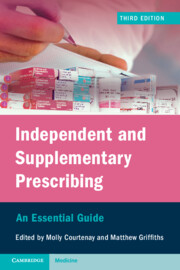Book contents
- Frontmatter
- Contents
- List of Contributors
- Foreword
- Preface
- 1 Non-Medical Prescribing: An Overview
- 2 Non-Medical Prescribing in a Multidisciplinary Team Context
- 3 Consultation Skills and Decision Making
- 4 Legal Aspects of Independent and Supplementary Prescribing
- 5 Ethical Issues in Independent and Supplementary Prescribing
- 6 Psychology and Sociology of Prescribing
- 7 Applied Pharmacology
- 8 Monitoring Skills
- 9 Promoting Concordance in Prescribing Interactions
- 10 Evidence-Based Prescribing
- 11 Extended/Supplementary Prescribing: A Public Health Perspective
- 12 Calculation Skills
- 13 Prescribing in Practice: How It Works
- 14 Minimising the Risk of Prescribing Error
- 15 Education and Training to Become a Prescriber
- 16 Antimicrobial Prescribing
- Index
14 - Minimising the Risk of Prescribing Error
Published online by Cambridge University Press: 23 December 2021
- Frontmatter
- Contents
- List of Contributors
- Foreword
- Preface
- 1 Non-Medical Prescribing: An Overview
- 2 Non-Medical Prescribing in a Multidisciplinary Team Context
- 3 Consultation Skills and Decision Making
- 4 Legal Aspects of Independent and Supplementary Prescribing
- 5 Ethical Issues in Independent and Supplementary Prescribing
- 6 Psychology and Sociology of Prescribing
- 7 Applied Pharmacology
- 8 Monitoring Skills
- 9 Promoting Concordance in Prescribing Interactions
- 10 Evidence-Based Prescribing
- 11 Extended/Supplementary Prescribing: A Public Health Perspective
- 12 Calculation Skills
- 13 Prescribing in Practice: How It Works
- 14 Minimising the Risk of Prescribing Error
- 15 Education and Training to Become a Prescriber
- 16 Antimicrobial Prescribing
- Index
Summary
Many health professionals have extended patient care roles and prescribe as supplementary prescribers in partnership with independent prescribers or independently in their own right. However, all prescribers can be vulnerable to the same systemic causes of prescribing error. Prescribing errors, unless detected by another person involved in medicine use, lead to incorrect medicines being taken or given, with the risk of harm. All prescribers need to be vigilant and aware of potential causes of errors in decision making or miscommunication during the prescription writing process such as incomplete knowledge of the patient’s medical condition and treatment, look-alike and sound-alike drug names, illegible handwriting, use of abbreviations, unusual dose frequencies and drug selection errors in electronic prescribing systems. Prescribers also need to consider actions that should be taken to minimise the risk of prescribing error, e.g. knowledge of electronic the prescribing system, prescription writing standards (including for controlled drugs), prescribing of biological medicines by brand name and awareness of high-risk drugs linked to problematic polypharmacy in older adults
Keywords
- Type
- Chapter
- Information
- Independent and Supplementary PrescribingAn Essential Guide, pp. 286 - 291Publisher: Cambridge University PressPrint publication year: 2022



